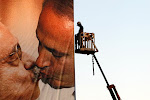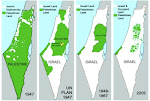IDF probes improper use of phosphorus shells inside Gaza Strip

After Israeli ground troops rolled out of the Gaza Strip before dawn Wednesday, they redeployed on the Israeli side of the border, poised for action if militants violated a fragile, three-day-old truce. Journalists also are massing on the southern Rafah crossing from Egypt and at Erez,near the northern frontier of the enclave, kept at arm's length for weeks by media-savvy Israeli government officials, who discouraged the dissemination of photographs that show the extensive damage. "It's not Stalingrad. Gaza wasn't carpet bombed," the BBC observed after two correspondents finally were allowed in following the ceasefire announcement. Photographs (above and below) of shells fired at UNRWA shelters and storehouses were released today by the UN agency, which has suggested that the Jewish nation ought to be investigated for war crimes because of phosphorus use.
Meanwhile the Israel Defense Forces are examining whether a reserve paratroops brigade made improper use of phosphorus shells during the fighting in Gaza, Haaretz reports today.
The brigade fired about 20 such shells in a built-up area of northern Gaza.
Aside from this one case, the shells were used, in the army's view, in "compliance with international law."
The IDF's use of phosphorus shells has sparked great criticism both in Israel and in the international media. The army therefore appointed Col. Shai Alkalai, an artillery officer, to investigate the issue, and his probe is still in progress.
According to senior army officers, the IDF used two phosphorus-based weapons in Gaza. One, the sources said, actually contains almost no phosphorus. These are simple smoke bombs - 155mm artillery shells - with a trace of phosphorus to ignite them.
Alkalai's probe is thus focusing on the second type: phosphorus shells, either 81mm or 120mm, that are fired from mortar guns. About 200 such shells were fired during the recent fighting, and of these, according to the probe's initial findings, almost 180 were fired at orchards in which gunmen and rocket-launching crews were taking cover.
The one problematic incident was the reserve paratroops brigade that fired about 20 such shells in a built-up area of Beit Lahiya. Many international organizations say phosphorus shells should not be used in heavily populated areas. The brigade's officers, however, say the shells were fired only at places that had been positively identified as sources of enemy fire.
The 120mm shells, a recent acquisition, have a computerized targeting system attached to a GPS. Brigade commanders say they were very effective, but they were also responsible for two very serious mishaps: a strike on a UNRWA school that killed 42 Palestinians and a friendly fire incident that seriously wounded two officers.

Earlier in the month, on January 13, Israeli officials announced that one of the rockets fired by Hamas into Israel contained white phosphorus and that this posed a new threat.
It's unclear if the white phosphorous was gathered from spent Israeli weapons or if it was smuggled in through tunnels. The remaining tunnels that riddle the southern border apparently are doing a thriving business, even after the destruction of so many by the IDF bombs.




















No comments:
Post a Comment